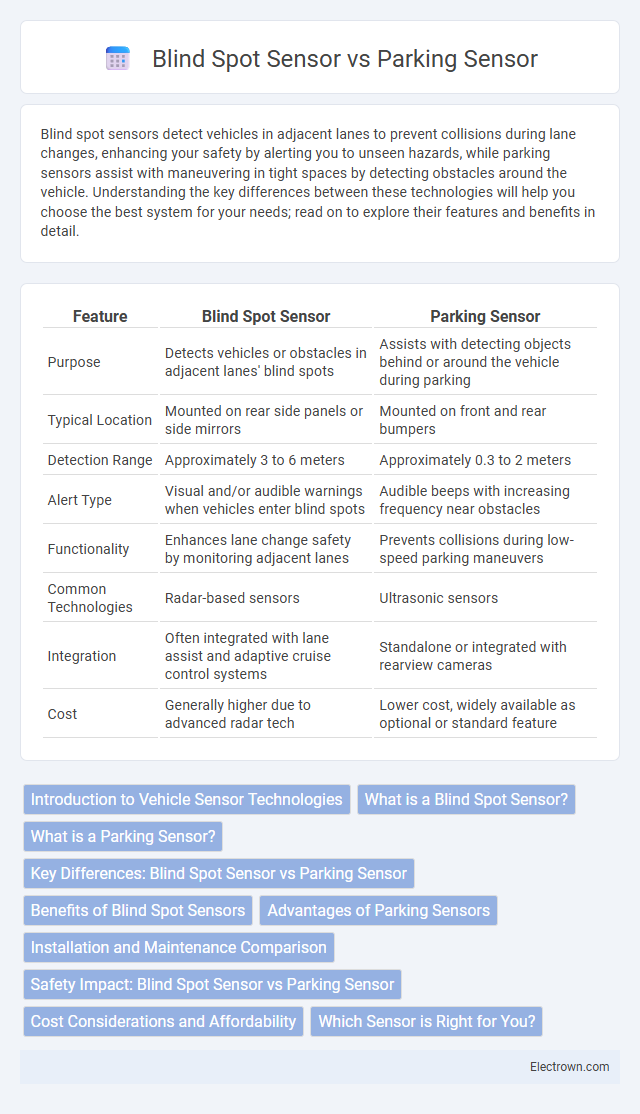Blind spot sensors detect vehicles in adjacent lanes to prevent collisions during lane changes, enhancing your safety by alerting you to unseen hazards, while parking sensors assist with maneuvering in tight spaces by detecting obstacles around the vehicle. Understanding the key differences between these technologies will help you choose the best system for your needs; read on to explore their features and benefits in detail.
Table of Comparison
| Feature | Blind Spot Sensor | Parking Sensor |
|---|---|---|
| Purpose | Detects vehicles or obstacles in adjacent lanes' blind spots | Assists with detecting objects behind or around the vehicle during parking |
| Typical Location | Mounted on rear side panels or side mirrors | Mounted on front and rear bumpers |
| Detection Range | Approximately 3 to 6 meters | Approximately 0.3 to 2 meters |
| Alert Type | Visual and/or audible warnings when vehicles enter blind spots | Audible beeps with increasing frequency near obstacles |
| Functionality | Enhances lane change safety by monitoring adjacent lanes | Prevents collisions during low-speed parking maneuvers |
| Common Technologies | Radar-based sensors | Ultrasonic sensors |
| Integration | Often integrated with lane assist and adaptive cruise control systems | Standalone or integrated with rearview cameras |
| Cost | Generally higher due to advanced radar tech | Lower cost, widely available as optional or standard feature |
Introduction to Vehicle Sensor Technologies
Blind spot sensors and parking sensors are advanced vehicle sensor technologies designed to enhance driver awareness and safety. Blind spot sensors use radar or ultrasonic waves to detect vehicles or obstacles in adjacent lanes, providing alerts to prevent collisions during lane changes. Parking sensors utilize ultrasonic sensors to measure the distance between the vehicle and nearby objects, aiding drivers in maneuvering and avoiding obstacles while parking.
What is a Blind Spot Sensor?
A Blind Spot Sensor is an advanced vehicle safety feature designed to detect objects or vehicles in the driver's blind spots, areas that are not visible through mirrors alone. It uses radar or ultrasonic technology to monitor adjacent lanes and alert you to potential hazards, helping prevent collisions during lane changes. Unlike parking sensors, which primarily assist with detecting obstacles while parking, blind spot sensors enhance overall driving safety by continuously scanning and warning you of nearby vehicles.
What is a Parking Sensor?
A parking sensor is an electronic device installed on a vehicle's bumper that detects obstacles during parking maneuvers, assisting drivers in avoiding collisions. It uses ultrasonic or electromagnetic waves to measure the distance between the vehicle and surrounding objects, providing audible or visual alerts. Unlike blind spot sensors, parking sensors specifically focus on low-speed environments, enhancing safety during parking and tight-space navigation.
Key Differences: Blind Spot Sensor vs Parking Sensor
Blind spot sensors detect vehicles in adjacent lanes to alert you of potential hazards during lane changes, enhancing safety on highways. Parking sensors assist in low-speed maneuvers by detecting obstacles near your vehicle's front or rear, preventing minor collisions while parking. Both systems use ultrasonic or radar technology but serve distinct purposes--blind spot sensors focus on lateral awareness, whereas parking sensors provide close-range obstacle detection.
Benefits of Blind Spot Sensors
Blind spot sensors enhance driver safety by detecting vehicles in areas that are difficult to see, reducing the risk of collisions during lane changes. They provide real-time alerts, improving situational awareness and helping to prevent accidents in busy traffic conditions. These sensors complement parking sensors by offering continuous monitoring beyond low-speed maneuvers, contributing to overall road safety.
Advantages of Parking Sensors
Parking sensors provide precise distance feedback, significantly reducing the risk of minor collisions while maneuvering in tight spaces. They enhance spatial awareness by detecting obstacles around the vehicle, including low-lying objects that may not be visible through mirrors or cameras. Unlike blind spot sensors, parking sensors offer immediate auditory or visual alerts tailored specifically for close-range parking scenarios, improving overall vehicle safety and ease of parking.
Installation and Maintenance Comparison
Blind spot sensors require professional installation due to their integration with vehicle electronics and radar systems, ensuring accurate detection of adjacent vehicles. Parking sensors are generally easier to install, often available as plug-and-play kits that can be mounted on bumpers with minimal wiring. Maintenance for blind spot sensors includes regular calibration and sensor cleaning to prevent interference, while parking sensors primarily need periodic checks for dirt or debris accumulation to maintain functionality.
Safety Impact: Blind Spot Sensor vs Parking Sensor
Blind spot sensors enhance safety by detecting vehicles in adjacent lanes, significantly reducing the risk of side collisions during lane changes. Parking sensors provide audible or visual alerts to prevent low-speed impacts with nearby obstacles, aiding drivers in tight parking situations. Both systems improve situational awareness, but blind spot sensors directly address high-speed lane change hazards, while parking sensors primarily prevent parking lot mishaps.
Cost Considerations and Affordability
Blind spot sensors typically involve higher costs due to advanced radar and camera technology, often ranging from $200 to $500 per sensor, plus installation fees, making them a more significant investment for vehicle safety. Parking sensors are generally more affordable, with prices starting around $50 to $150 per sensor, and simpler installation processes help keep overall expenses lower. Budget-conscious buyers may prefer parking sensors for basic proximity alerts, while those prioritizing comprehensive blind spot detection might justify the increased cost of blind spot sensors.
Which Sensor is Right for You?
Blind spot sensors monitor adjacent lanes to alert you of vehicles in hard-to-see areas, enhancing safety during lane changes. Parking sensors detect obstacles around your vehicle at low speeds, providing audible or visual warnings to assist with maneuvering in tight spaces. Your choice depends on whether you prioritize lane-change awareness or precise parking assistance in your daily driving.
Blind spot sensor vs Parking sensor Infographic

 electrown.com
electrown.com